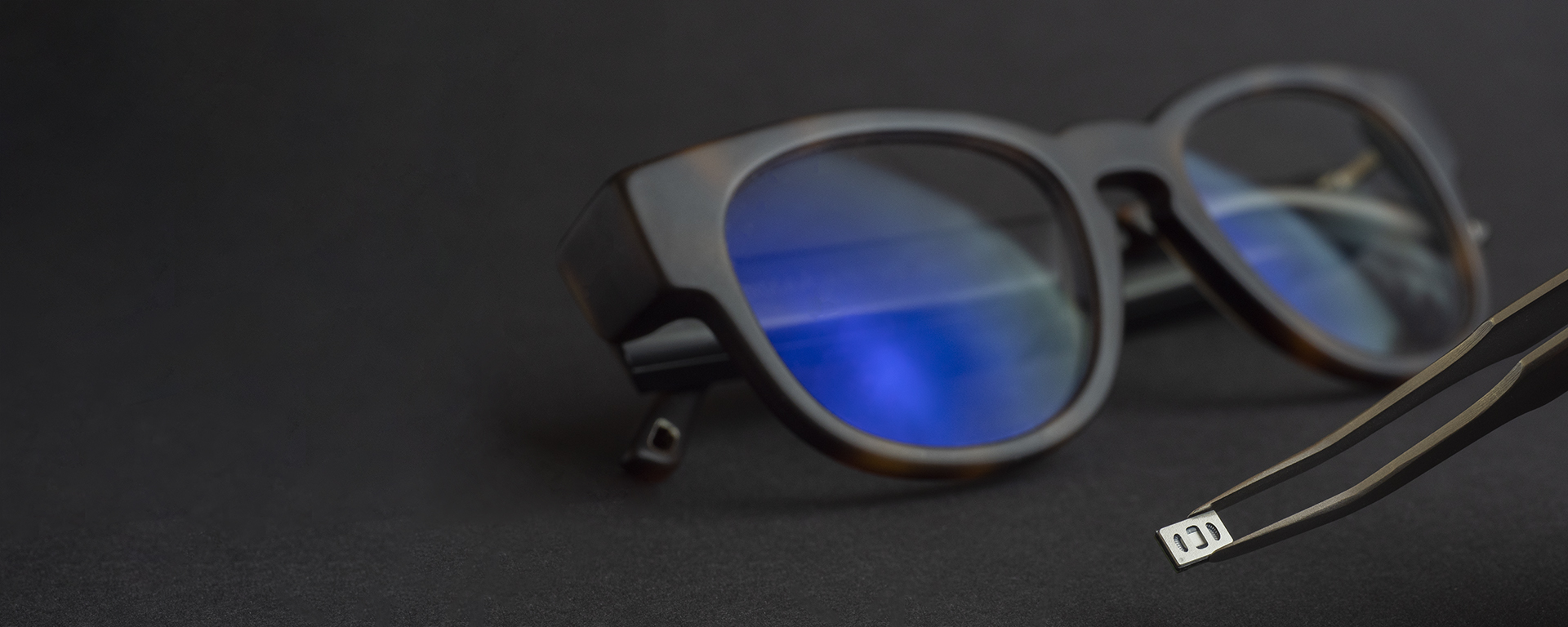
Published:
How MEMS speakers can improve the audio module of smart eyewear and audio glasses
Audio-enabled eyewear refers to head-worn devices that enable users to interact with audio content, such as music, podcasts, games of phone calls. Such devices will necessarily contain loudspeakers and the acoustic volumina needed by them, typically contained in an audio module. This article will explain how USound’s MEMS technology can significantly improve the size and performance of such audio modules.
As the market of audio-enabled eyewear is growing rapidly, distinct product categories can be observed, such as:
- Audio glasses (glasses with wireless audio technology)
- AR glasses (augmented reality, head-worn devices with see-through displays)
- VR glasses (virtual reality, head-worn devices that fully obstruct and replace the view of the user with a binocular display)
- MR glasses (mixed reality, a combination of AR and VR, typically achieved via forward-facing cameras and a binocular display)
All these product categories will have a need to replay acoustic signals to the user, be it voice signals from a phone call, music, in-game sound or other notifications. But as each of these devices has a specific incentive to use as little space as available, miniaturization of the audio components becomes vital in order to fit all needed components into the small space available.
The demand of consumers for both ergonomic and small devices is counterproductive to the request for high-quality audio. Using MEMS speakers allows to minimize the space taken up by the audio portion and be more flexible with the industrial design (ID). In this article we showcase USound’s approach to the audio component of smart eyewear, highlighting USound’s micro-2-way system design. This design was integrated into the FAUNA Audio Glasses.
Micro 2-way system
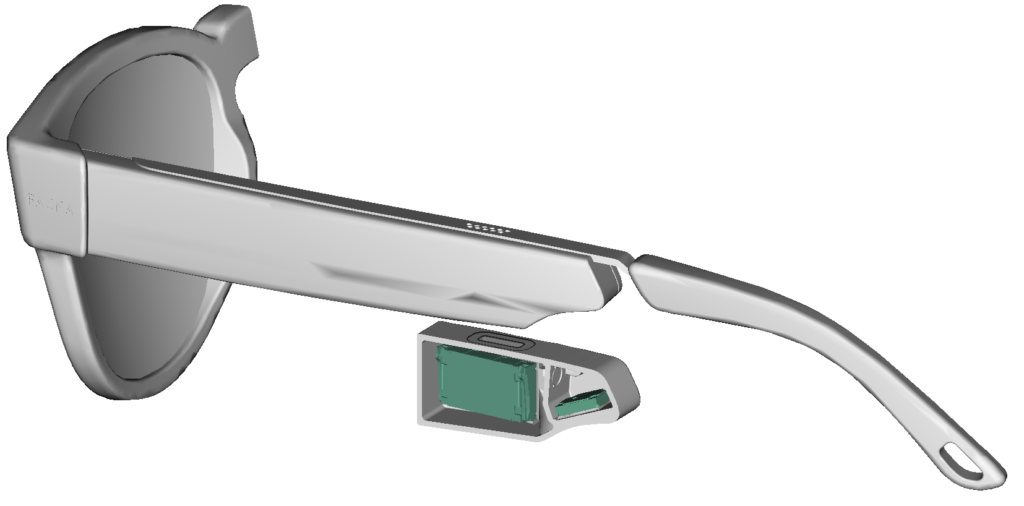
a. Size advantage of using a micro-2-way system
The main problem in miniaturizing the audio components is the size of the loudspeaker. To achieve acceptable sound quality, a single loudspeaker must have a relatively large size, which will be a dominating factor in the device’s industrial design. Splitting up the loudspeaker component into two separate devices – a woofer for low frequencies and a tweeter for high frequencies – allows for the design to be much more flexible. Contact us via e-mail for design guidelines.

As seen in Figure 2, when using a single large loudspeaker, the design of the eyewear device will be dominated by the maximum dimension of the loudspeaker. This necessitates a relatively bulky design of the eyewear’s temples, leaves little freedom to the industrial designer. Compared to this, a micro-2-way system takes up less space (in terms of volume), but more importantly, it consists of two separate loudspeakers which can be placed more flexibly, giving more freedom to the industrial designer. The next picture shows how this flexibility was used in arranging the loudspeakers of the are arranged in the Fauna Audio Glasses to save space.

In direct comparison it is obvious how the micro-2-way system not only reduces total space consumption but also allows for a much less bulky design, as the shape of the device is no longer dominated by the dimensions of the loudspeaker.

As seen in Figure 4, the micro-2-way system allows for much more flexibility and hence a sleeker design of the temple. The ID is no longer dominated by the diameter of the speaker. And since the acoustic performance is now spread across two individual components, sound quality is at least equal thanks to the use of miniature USound MEMS speakers as a tweeter.
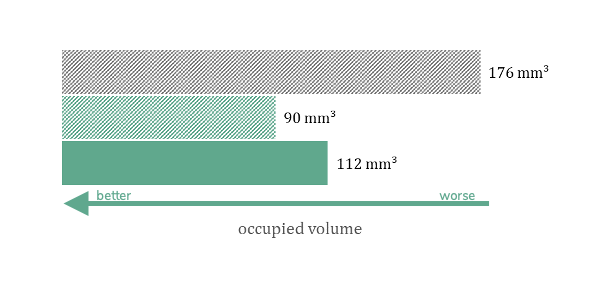
b. Acoustic performance
The above benefits are achieved by trading the large loudspeaker for a smaller one. While this will affect the performance, especially at high frequencies – where smaller electrodynamic speakers often exhibit several resonance modes – this is easily fixed by using a dedicated MEMS tweeter. Due to their small size they can be used in a front-firing orientation, which significantly improves behavior at high frequencies. As shown in Figure 6, adding one USound MEMS loudspeaker helps extend the range of useable frequencies. This greatly improves the perceived clarity of the signal and helps with the intelligibility of speech signals.
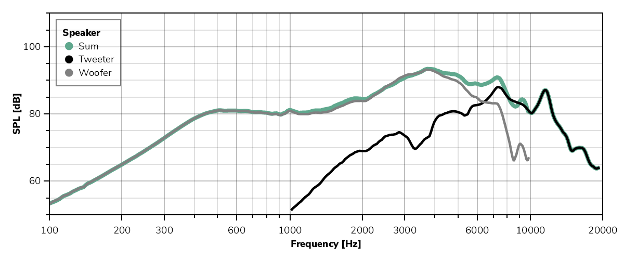
c. Power consumption advantages
It seems counterintuitive, but using two separate speakers can improve power consumption on audio components due to using USound MEMS speakers for the tweeter. Figure 7 shows power efficiency figures with the following test conditions:
- Stimulus: IEC 60268-1 noise, 12 dB crest factor
- Acquisition: Current draw on 3.7V supply voltage
- Amplifier: TPA2028D1 (Electrodynamic speakers) / LM48580 (MEMS speakers)
- SPL measured at EEP (Ear Entrance Point)
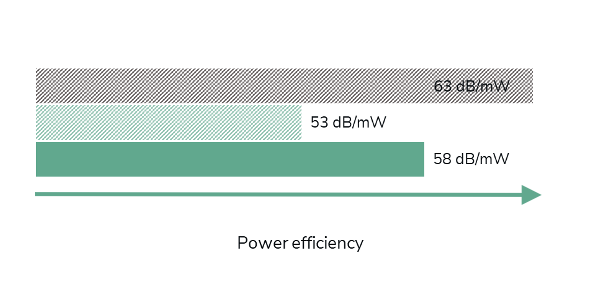
d. Design flexibility


Splitting up a large speaker into two smaller speakers enables the industrial designer to be much more flexible with regards to component placement and allows for much sleeker designs. A variety of shapes are possible, since the two components can be arranged in different ways to fit the ID, and the outer shape is no longer dominated by the diameter of the speaker the way it would be if using a single large speaker. Figure 8 shows a variety of designs that are enabled by using a micro-2-way-system directly integrated into the temple of an eyewear product. For manufacturers that want to outsource acoustic design, the acoustic components can also be placed into a separated module (which can also contain the necessary driving electronics). The design flexibility is still there when using audio modules – Figure 9 shows a variety of module designs that are enabled by using a micro-2-way system used by our customers.
e. Summary
In a nutshell, a micro-2-way-system
- can increase the bandwidth at high frequencies
- takes up significantly less space than a single large speaker
- is more power-efficient than using a single small speaker
- offers the best compromise between space consumption and power consumption
- gives the industrial designer more freedom in placing the components as each separate component uses up less space
How to start
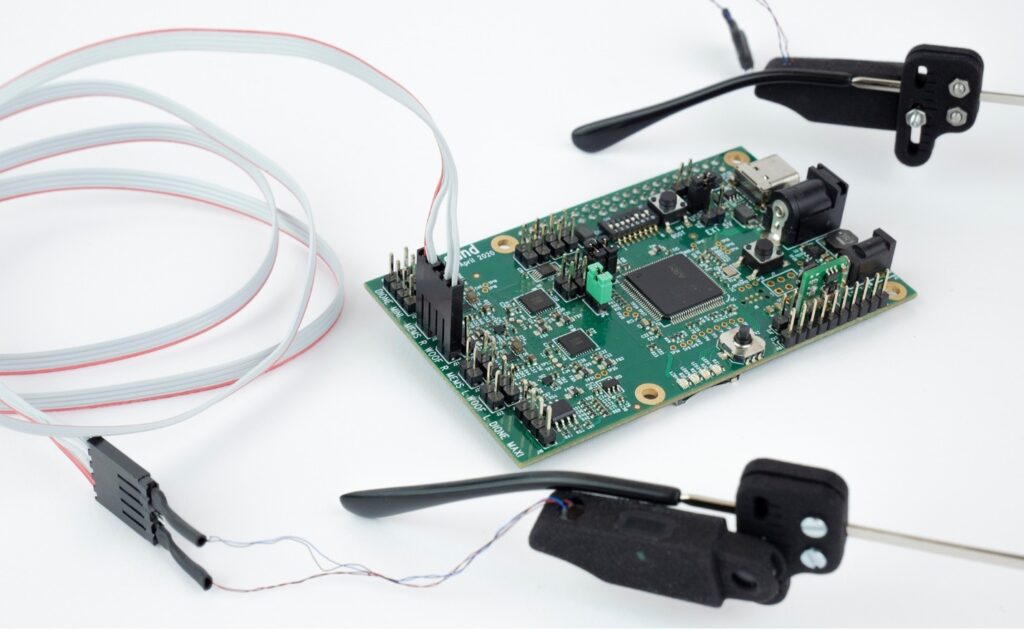
Helike 1.0 UA-E3010
Helike 1.0 is a development board with amplifiers capable of simultaneously driving electrodynamic and MEMS speakers. This board can be used to supply the signal to the speakers and contains a DSP, which can be configured to act as a crossover and apply filtering to the signal.
This allows for rapid assessment of USound MEMS speaker-based products, rapid prototyping, and designing, as the board will easily interface with your existing setup: It can be used in standalone mode (playing files from an SD card), act as a USB audio interface (UAC 2.0) and can also be addressed via I2S (e.g., from a Raspberry Pi via 40 Pin GPIO interface)
Danube 5.0 UAM-P2050
Danube 5.0 is an audio module demonstrator and rapid prototyping kit for audio/AR/VR glasses. It uses the same acoustic design as the Fauna audio glasses, showcasing the small form factor that can be achieved with a micro-2-way system. It also includes our proprietary audio-privacy technology to reduce the amount of sound radiated to the side to minimize the amount of sound audible to third parties.
Danube 5.0 UAM-P2050 can be connected directly to Helike, which provides the amplifiers, DACs, digital crossover, and filters to evaluate the concept of a micro-2-way system quickly.
Design your own! Using a micro-2-way-system for your product
To get help with designing the audio part of your glasses, contact our Field Application Engineers for design guidelines. We can assist you in choosing speakers, dimensioning acoustic volumes, placement and size of sound ports, the influence of resonators, and achieving maximum audio privacy. We will gladly support you in designing your own audio glasses or the audio component of AR/VR/XR glasses. You can also outsource the design and/or manufacturing of the audio components as an audio module to us. Write us an email!
This article was originally written by Konstantin Davy, a former team member, and has been updated by our editorial team on 07.04.2025 to reflect current best practices.

